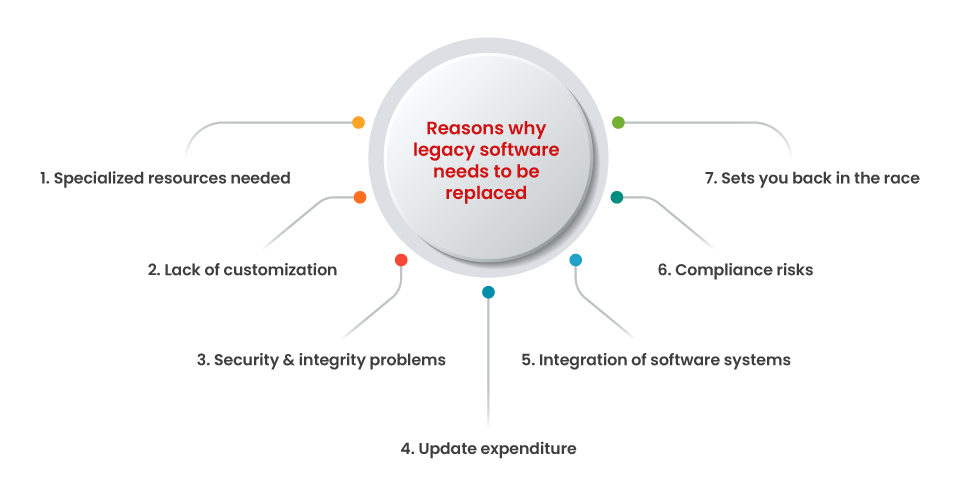
The world is changing and most essentially speeding up, this is something that holds true for businesses more than anything else. Businesses in more times demand dynamism and the agility to be able to change processes as and when they are needed without having to struggle with IT-related issues.
Unfortunately, there are legacy software systems that are very often left as they are and not changed for a lot of different reasons. While there are reasons not to switch from legacy software to more modern options, there are more reasons why the change is needed and needed now.
In order for businesses to identify the downside of legacy software, they need to understand what it is and how it affects the business in an adverse manner. Legacy software systems are the ones that were used many years ago by businesses and which once served as efficient and handy tools for streamlining business needs. However, as time passes, the digital world has been experiencing quick changes that legacy systems are not able to keep up with. It is, therefore, important for businesses to adopt IT modernization and more flexible solutions such as no-code so that they are able to make for a more fluid and flexible environment for the business to grow.
Interestingly, as per a report by Gartner, 65% of all application development by businesses will be done through no-code or low-code platforms as early as 2024. This goes to show that the future truly is ‘no-code’ for businesses that want their graph to be on a steady upward incline.
Reasons why Legacy Enterprise Systems needs to be replaced
Though businesses are coming to terms with the fact that legacy software systems need to go, it is important to understand why they truly need to be replaced with new-age alternatives. Apart from spending time and resources on handling legacy software systems, here are some important reasons why they need to be changed:

1. Specialized resources needed
When you have to maintain and use legacy software that only a few know how to use optimally, you also need to ensure that you invest the means to maintain the specialized resources. Newer resources may not be able to troubleshoot problems that you may face with age-old software systems. It can eventually turn into a costly affair to find and retain staff that can work on rigid software systems that are not easily customizable.
2. Lack of customization
When you need to effectively mobilize and accomplish work, you need to make sure that you have all hands on deck, and that is possible when you have a system that everyone can use. Legacy software can lead to only a few people putting it to use but on the other hand, customizable solutions like no-code can help in making sure that the system is customized for everyone to put to effective use. Customization helps empower more people to work, increasing the productivity of the business on the whole.
3. Security & integrity problems
One of the biggest issues that are faced by the IT teams of any business is maintaining the security and integrity of the business data. With the use of legacy software, it is possible that the security and encryption may not be up to the mark as times advance. However, with the use of replacements such as no-code from reliable service and platform providers, it can be ensured complaint systems certified by AICPA and the likes are employed. It can also be ensured that platforms with the most secure cloud infrastructure is put to use for business functions so that enhanced security is achieved. It is also important that businesses rely on systems that are put through regular penetration tests to solidify security for the users.
Also Read: Enterprise Digital Transformation: Seamlessly Bridging the Gap
4. Update expenditure
When you have a legacy system for use, it is natural that you also have to spend a great deal on updates and maintenance. Not only does the software itself cost a great deal, but the experts that are required for the maintenance and the smooth working of the software also need to be hired at elevated costs because of the experience and expertise that is needed in maintaining the software. On the other hand, an investment in cloud-based and highly customizable no-code solutions can help you keep the system updated without the need for a professional developer. No-code, as the name suggests, can be used in application building and business process creation without the use of a single line of code.

5. Integration of software systems
In the use of legacy software, it is nearly impossible to integrate the old software with new systems, which means that seamlessness in business functioning becomes a distant dream. However, if you transition to the use of systems like no-code, it is possible to not just build new applications from scratch but also bridge existing software systems to make them stronger and more effective in serving business needs.
6. Compliance risks
It is highly likely that the legacy software you use for the functioning of your business may not meet the compliance and regulatory standards of modern times. The rules go on changing according to the changing times, which means that anything that falls under legacy software may no longer be adhering to compliance standards of the yore.
7. Sets you back in the race
While your competitors may have moved to newer, more innovative, and highly agile options in software, you may still be stuck with something that is no longer productive for your business. The use of software systems that are inferior to those of your competitors deals a direct hit to the way in which your venture progresses. Since we live in times of cut-throat competition, it only makes sense to keep up with the times and invest in software that is customizable and can be changed or upgraded as the times change.
Also read: Top 10 Benefits of No-Code App Development
Dealing with the problems using No-Code!
While it is clear that legacy software needs to go and new-age innovative solutions need to replace the old systems, a lot of businesses still struggle with the question of what is an ideal replacement option. The answer is simple, no-code solutions are the best for any kind of business, here are some reasons why:
1. Helps ease out evolution
Change is constant in modern-day businesses, and that is something that should not just be not road-blocked by software systems but instead be enabled and enhanced. No-code solutions make for ideal tools for the evolution and progress of business ventures. The solutions help give the power of innovation into the hands of those that are not professional developers, which means that more heads can work towards the progress of the company.
2. Add to existing tools
No-code solutions don’t just help in creating new tools and applications for running business functions but also aid in creating bridges for existing software systems. It is natural that a one-size-fits-all off-the-shelf-commercial software system cannot be perfect for your business. The use of no-code solutions helps enhance existing systems to provide optimal productivity and agility to your enterprise.
3. Works with all business functions
A no-code solution helps in the running of all sorts of business functions, right from HR processes to marketing to operations, sales, and more. This means that you can get your hands on a magic wand of enterprise solutions if you have access to just one good no-code platform.

4. Enhances security systems
With the use of a highly secure and compliant no-code solution, it is possible to make sure that you have a robust and impermeable business process. The IT teams of businesses can find great solace when you have access to secure no-code solutions since they are process-driven and usually come with multiple security and access options.
5. Promotes employee satisfaction
If you have the provision for the employees to use digitization tools such as no-code, it is possible that they will remain much more focused on productive work. Employees very often find themselves being occupied with tasks such as paperwork or replying to emails, all of which can be streamlined with the help of flowchart building and business process creation tools.
Also Read: Evolve, Don’t Replace with Quixy – Overcoming Legacy System Gaps
Conclusion
It can be concluded that no-code is the way forward and it will soon be replacing all sorts of legacy software systems that are used in business processes. With the demand for customization, digitization, flexibility, and agility in businesses on the rise, it is natural for no-code solutions to take center stage, bidding goodbye to legacy software solutions that seldom do little more than burn a hole through your pocket!
Login
Please login to comment
0 Comments
Oldest















